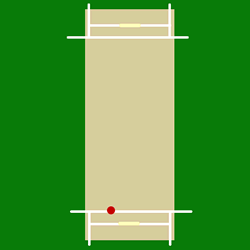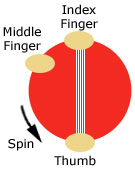Related Research Articles

Leg spin is a type of spin bowling in cricket. A leg spinner bowls right-arm with a wrist spin action. The leg spinner's normal delivery causes the ball to spin from right to left when the ball bounces on the pitch. For a right-handed batter, that is away from the leg side, and this is where it gets the name leg break.
A googly, also known as a wrong'un or Bosie, is a type of delivery in the game of cricket bowled by a right-arm leg spin bowler. It is different from the normal delivery for a leg-spin bowler in that it is turning the other way. The googly is not a variation of the typical off spin type of delivery, in that the cricket ball is presented from the bowler's hand in such a way that once the ball pitches; instead, it deviates in the opposite direction of a leg spinning type of delivery. It has also been colloquially referred to as the wrong'un, Bosie or Bosey, with the latter two eponyms referring to Bernard Bosanquet, the bowler who originally devised and began using the googly. He first employed it in July 1900, during the second innings of a County Championship match between Middlesex and Leicestershire at Lord's. In that game, Sam Coe became the first batter known to have been dismissed by a googly. During the Edwardian era, some considered its use to be an example of cheating.

A knuckleball or knuckler is a baseball pitch thrown to minimize the spin of the ball in flight, causing an erratic, unpredictable motion. The air flow over a seam of the ball causes the ball to change from laminar to turbulent flow. This change adds a deflecting force to the baseball, making it difficult for batters to hit but also difficult for pitchers to control and catchers to catch; umpires are challenged as well, as the ball's irregular motion through the air makes it harder to call balls and strikes. A pitcher who throws knuckleballs is known as a knuckleballer.

This is a general glossary of the terminology used in the sport of cricket. Where words in a sentence are also defined elsewhere in this article, they appear in italics. Certain aspects of cricket terminology are explained in more detail in cricket statistics and the naming of fielding positions is explained at fielding (cricket).

In baseball, the pitch is the act of throwing the baseball toward home plate to start a play. The term comes from the Knickerbocker Rules. Originally, the ball had to be thrown underhand, much like "pitching in horseshoes". Overhand pitching was not allowed in baseball until 1884.
In the sport of cricket, a bouncer is a type of short-pitched delivery, usually bowled by a fast bowler, which bounces once and then reaches the batter at head-height.
Seam bowling is a bowling technique in cricket whereby the ball is deliberately bowled on to its seam, to cause a random deviation when the ball bounces. Practitioners are known as seam bowlers or seamers.
An outswinger is a type of delivery of the ball in the sport of cricket. In such a delivery the ball curves—or "swings"—out and away from the batter's body and the wicket. By contrast, an inswinger swings in toward the batter and the wicket. Outswingers are bowled by swing bowlers.
An inswinger is a type of delivery of the ball in the sport of cricket. In such a delivery the ball curves—or "swings"—in toward the batter's body and the wicket. By contrast, an outswinger swings away from the line of the batter and the wicket. Inswingers are bowled by swing bowlers.

An off cutter is a type of delivery in the game of cricket. It is bowled by fast bowlers.
In the sport of cricket there are two broad categories of bowlers: pace and spin. Pace bowlers rely mostly on the speed of the ball to dismiss batsmen, whereas spin bowlers rely on the rotation and turn off the ball to deceive the batter.
In baseball, an off-speed pitch is a pitch thrown at a slower speed than a fastball. Breaking balls and changeups are the two most common types of off-speed pitches. Very slow pitches which require the batter to provide most of the power on contact through bat speed are known as "junk" and include the knuckleball and the Eephus pitch, a sort of extreme changeup. The specific goals of off-speed pitches may vary, but in general they are used to disrupt the batter's timing, thereby lessening his chances of hitting the ball solidly or at all. Virtually all professional pitchers have at least one off-speed pitch in their repertoire. Despite the fact that most of these pitches break in some way, batters are sometimes able to anticipate them due to hints that the pitcher gives, such as changes in arm angle, arm speed, or placement of fingers.
In the sport of cricket, a slower ball is a slower-than-usual delivery from a fast bowler. The bowler's intention is to deceive the batsman into playing too early so that he either misses the ball completely or hits it high up in the air to offer an easy catch. It is analogous to a changeup in baseball.

A delivery or ball in cricket is a single action of bowling a cricket ball toward the batter. Once the ball has been delivered, batters may attempt to score runs, with the bowler and other fielders attempting to stop this by getting the batters out. When the ball becomes dead, the next delivery can begin.
Wrist spin is a type of bowling in the sport of cricket. It refers to the cricket technique and specific hand movements associated with imparting a particular direction of spin to the cricket ball. The other spinning technique, usually used to spin the ball in the opposite direction, is finger spin. Wrist spin is bowled by releasing the ball from the back of the hand, so that it passes over the little finger. Done by a right-handed bowler, this imparts an anticlockwise rotation to the ball, as seen from the bowler's perspective; a left-handed wrist spinner rotates the ball clockwise.
Finger spin is a type of bowling in the sport of cricket. It refers to the cricket technique and specific hand movements associated with imparting a particular direction of spin to the cricket ball. The other spinning technique, generally used to spin the ball in the opposite direction, is wrist spin. Although there are exceptions, finger spinners generally turn the ball less than wrist spinners. However, because the technique is simpler and easier to master, finger spinners tend to be more accurate.
In cricket, a slider is a type of delivery bowled by a wrist spin bowler. While a topspinner is released with the thumb facing the batter, a slider is bowled in a similar manner to a legbreak, but instead of imparting sidespin with the third finger, the bowler allows his fingers to roll down the back of the ball, providing a mixture of sidespin and backspin. Whereas a topspinner tends to dip more quickly and bounce higher than a normal delivery, a slider does the opposite: it carries to a fuller length and bounces less than the batter might expect. The sliders will typically head towards the batter with a scrambled seam. This has less effect on the flight and bounce but absence of leg spin may deceive the batter. Frequently the slider is bowled with a mixture of side spin and backspin. This has the effect of making the ball harder to differentiate from the leg break for the batters without reducing the mechanical effects caused by the backspin. This delivery may skid straight on or it may turn a small amount.

Trent Alexander Boult is a New Zealand cricketer who represented the New Zealand cricket team in all formats between 2011 and 2024. He continues to play in various Twenty20 leagues around the globe as a fast bowler. Boult was a key member of the New Zealand team that won the 2019–2021 ICC World Test Championship. He was also a part of the New Zealand squads to finish as runners-up in two Cricket World Cup finals in 2015 and 2019.

Cricket is a bat-and-ball game played between two teams of eleven players on a field, at the centre of which is a 22-yard pitch with a wicket at each end, each comprising two bails balanced on three stumps. Two players from the batting team, the striker and nonstriker, stand in front of either wicket holding bats, while one player from the fielding team, the bowler, bowls the ball toward the striker's wicket from the opposite end of the pitch. The striker's goal is to hit the bowled ball with the bat and then switch places with the nonstriker, with the batting team scoring one run for each of these exchanges. Runs are also scored when the ball reaches the boundary of the field or when the ball is bowled illegally.

Jofra Chioke Archer is a Bajan-English cricketer who represents England in international cricket. He is a right-arm fast bowler. In domestic cricket he plays for Sussex as well as a number of T20 franchises. In April 2019, Archer was selected to play for the England team in limited overs fixtures against Ireland and Pakistan. He made his international debut for England in May 2019, and was part of the England squad that won the 2019 Cricket World Cup. He then made his Test debut later that summer, against Australia in the 2019 Ashes series. In April 2020, Archer was named as one of the Wisden Cricketers of the Year.
References
- ↑ "Yahoo Cricket". cricket.yahoo.net. Retrieved 2020-03-27.
- ↑ "The mystery of the knuckleball". ESPNcricinfo. 2017-03-19. Retrieved 2020-03-27.
- ↑ Selvey, Mike; Marks, Vic; Bull, Andy; Hopps, David (April 4, 2011). "Cricket World Cup: The writers' verdicts". The Guardian. London. Retrieved 7 October 2012.
- ↑ "7 innovative and interesting information of cricket world". Cyclicmint. 2020-02-14. Retrieved 2020-03-27.
- ↑ "Andrew Tye, and the magic of the knuckle ball". Cricbuzz. 14 April 2017. Retrieved 10 January 2019.
- ↑ Jack Watson (12 July 2019). "Cricket World Cup 2019: Jofra Archer's newfound mystery dazzles Australia as Ashes inclusion beckons". Independent. London. Retrieved 15 September 2019.